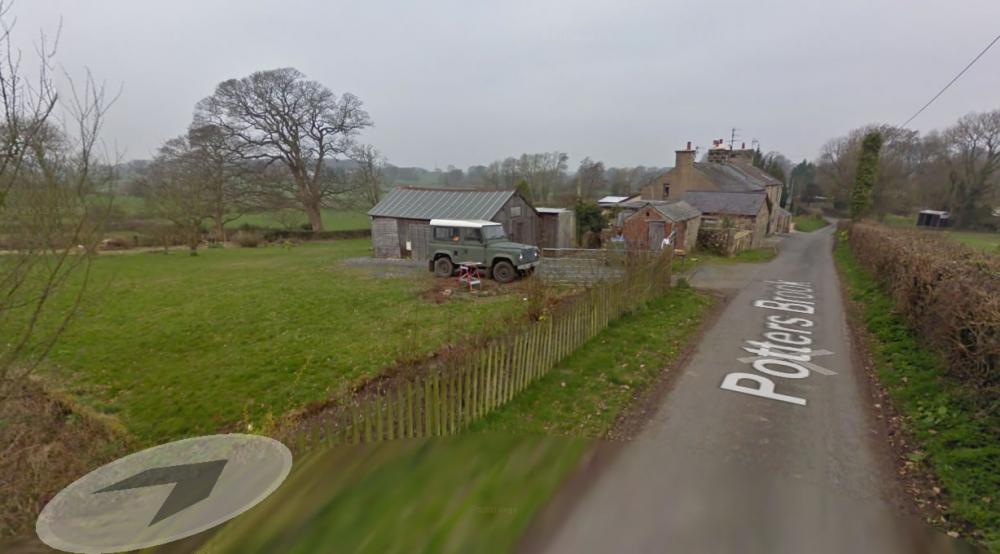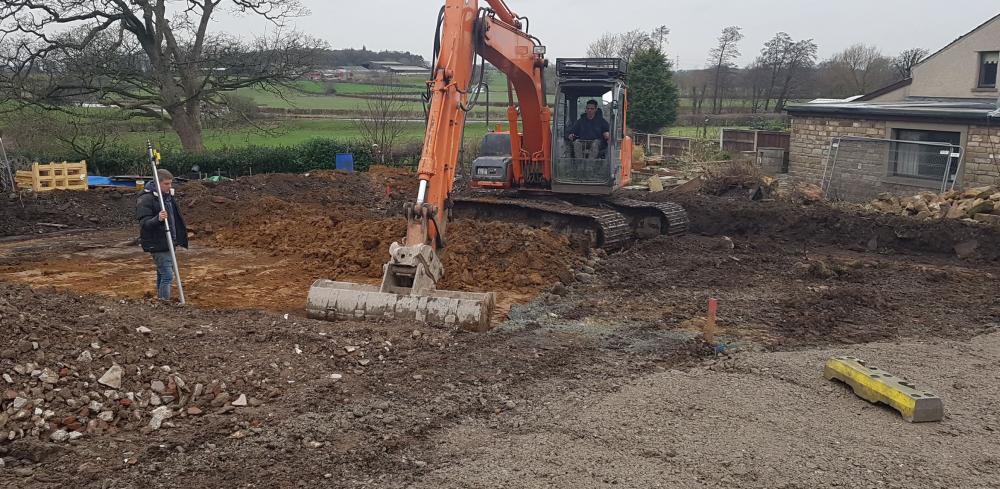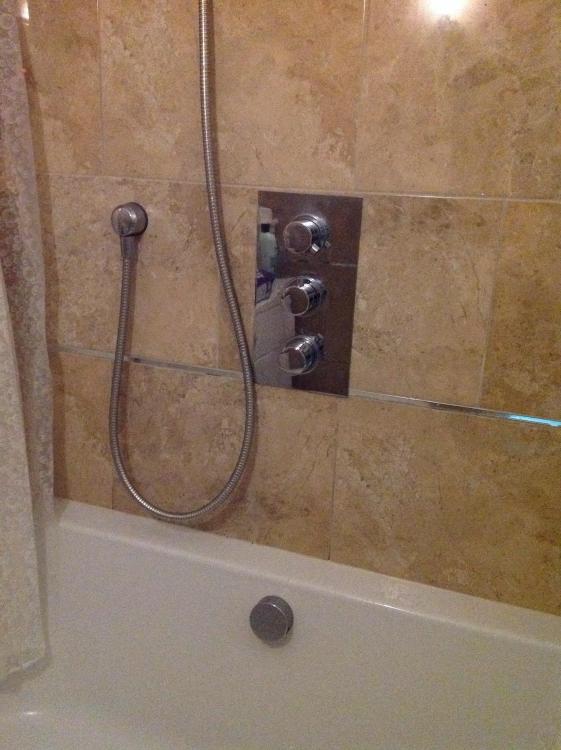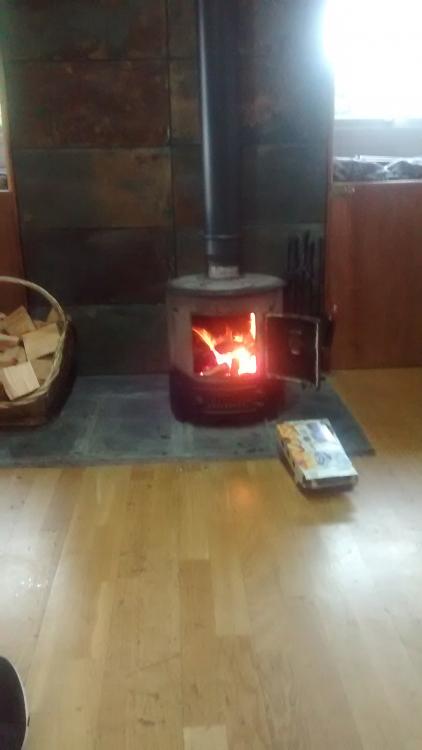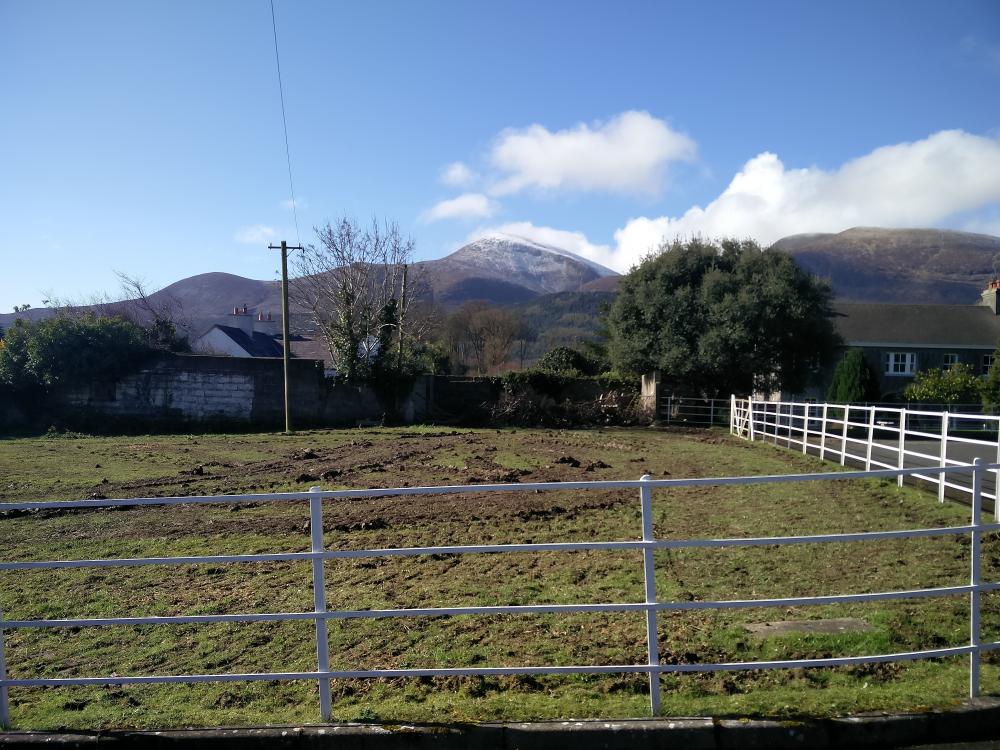Leaderboard
Popular Content
Showing content with the highest reputation on 02/06/17 in all areas
-
This looks like this today I had a look at my records: January 2014 was the moment we first thought we might have a go at a planning application because our colleagues told us it was worth a try. Many times we were advised (correctly by estate agent friends and others) not to bother. @MrsRA bought the orchard (which the digger is now levelling) in 1985. It's nearly 30 years since there was a glint in her eye about getting a house built here. When we've built the house we'll reinstate the orchard. Put your orders in for Damson jam quick as you like. I can't tell you what a relief it has been to get to today. Piling mat will be finished Wednesday, and the stone columns go in on Saturday. The BCOs (Approved Inspectors) are having a CPD session at our place on that day , so a couple of inspectors are coming to see the stone columns go in, and the piling company Town and Country Vibro is also having a company training session at the same time. Better go and buy some more tea bags.6 points
-
2 points
-
http://www.willesdenbathrooms.co.uk/media/catalog/product/cache/1/image/9df78eab33525d08d6e5fb8d27136e95/t/m/tmv-img-detail.jpg this might help2 points
-
The main risk with poorly fitting insulation is that there can be a pretty high temperature delta front-to-back and if there are gaps then air convection will start up in the cavity with the air (in your case) rising up between the Celotex and the inner porotherm leaf crossing over the Celotex in the cracks and dropping down the colder gap between the Celotex and the outer porotherm leaf. This circulating air then effectively acts as a heat pump pumping heat around the main insulation layer and reducing its effectiveness. The main way to prevent this type of internal convective circulation is to fix the insulation tight to one surface and to fill any gaps with foam. If the outer leaf hasn't gone up yet, have you though about using something like sticky foam to anchor it back. Might be worth a try.1 point
-
Guys. Slight plea from a Luddite ....... This thread is not in boffins corner, so.....can we have JFLAT's (Just a Few Less Abreviated Terms) Either that or provide a glossary IGMC TFYU HAGE Bar Knee1 point
-
Long pipes & insulation etc is fine. The only thing you need access to is the Temp+PRV, which is tank mounted as it has a temp probe, and the immersion. At 250 / 300 Ltr, you'll be able to select dual 3kw immersions so why not go that route for occasional 'boost'? That'll add another 6kw of heat input which, along with the ashp, should give you shower after shower after shower and still have headroom for a bath. The ashp will quickly start replenishing the heat as it depletes, and a combination of the two, when under duress, should be ample imo IF you go for a 350ltr cylinder. I know that's pushing your Monday to Friday envelope a bit, but you must design for your worst case scenario I'm afraid, and I think this would be the best option. Remember that if you fit the 15mm Steibel after the UVC, it can only service one bathroom. If you connect both rooms to it, you'll be strangling the 22mm hot outlet of the UVC and subjecting it to the max flow rate the instant will allow ( through said 15mm internals ). Very difficult to see how you'd 'provision' for retro fitting the Steibel at a later date as that would require a whole different approach to what should be a straight-forward UVC install ; UVC to manifolds in 22mm pipe. 15mm feeds to each room or outlet. Job done.1 point
-
Interesting. Our present house has a constructional hearth (it didn't need it) and one of my design "features" was I didn't want a raised hearth, so the finished, tiled surface of the hearth is dead flush with the surrounding wooden floor. BC never raised any issue with that.1 point
-
The regs say if the stove is certified "not to raise the hearth more than 100C" then you only need something 12mm thick but that 12mm must project above the surrounding floor, it cannot be flush with it. The idea is to stop rugs migrating too close. If using stone would make it thicker than 12mm (or well supported) because it will get stood on and it would be a shame to crack it. Our Clearview Solution 400 is sitting on a slab of black granite. I went to local monumental stone mason and he had a suitable offcut of kitchen worktop. He put it through his honing machine to take off the gloss. That's sitting on top of engineered wood, insulation and a beam & block floor.1 point
-
I found this guidance for non material amendments. I'm no expert I just Googled - There would be no alteration to the application site boundary and the proposal would be located within it (red line boundary). The amendment would not conflict with development plan policies or other Government guidance. There would be no conflict with any conditions on the planning permission. The proposal would not exacerbate concerns raised by third parties at original planning application stage. The approved footprint/siting of the building will not be moved in any direction by more than one metre. The proposal would not result in an extension to development already approved. The height/volume of the building or extension would not be increased. A reduction in the height/volume/size of the building/extension. The amendments must not result in a fundamental change in the design of the building. Does not amount to new works or elements not considered by any environmental statement submitted with the application. Amendments to windows/doors/openings that will not have any overlooking impact on neighbouring properties. As it's a height increase it may be a minor material amendment, however, assuming that the garage is lower than the house they may consider it non material. If I was you, I would apply for a NMA and see what they say. You could also just call up and ask depending on how helpful they are. If they say it is material then you have to make a variation or removal of condition application which is closer to a new application although has a lower fee.1 point
-
Well, I'm a man of my word..... I'll shut my mouth. . For everyone who didn't know, I asked. Bingo.1 point
-
It was a while ago. just looked now and there are a lot for between £20-£25 http://www.ebay.co.uk/itm/Altecnic-15mm-Thermostatic-Mixing-Valve-TMV3-CA-100822-/201806511080?hash=item2efc9afbe8:g:ltcAAOSw4DJYlbKm1 point
-
@Nickfromwales The PCM cells in the SAPVs do contain internal PHEs, but this isn't a conventional PHE with primary and secondary sides. On one side is the phase change material (PCM) and water on the other. There is only one water path and that is the potable DCW to DHW. The 500ml expansion vessel is on this, and the only active device between this and the DHW output is a TMV. I've emailed you the diagram that I referred to.1 point
-
We had useful checklists at EBuild. Since I am looking at plots, I thought it would be useful to make a start with things that can be checked or thought about before actually purchasing the plot. I am looking for questions, issues, places where checks can be done, and useful sources of information. Please drop any useful thoughts and links in the thread, then when we have done a bit the admins can decide where to put it if worth preserving. -------------------------------------------- ** References Wayleaves: These are rights for third parties to use your land which do not provide the owner with services, eg to put an electricity pole or have oversailing wires. They may be mentioned in deeds, or enshrined in an agreement, and you may (or may not) be able to get them moved unilaterally or by agreement, for no money or at significant cost. Discussed on buildhub in this thread: Wayleaves and Overhead Wires. ----------------------------------------------- ** Information I am looking for for the checklist: Sewers - Where can we get maps? Checking Boundaries. Checking for TPOs. How to look at Former Planning Permissions. Check details of former sales listings. Check viability of road access. What can I tell about the ground conditions from inspection of the plot. How to check previous site usages.1 point
-
I DREAD it when I've cut a bit of PIR to go between joists. "Shaving" the edge is ten times worse than the initial cut.1 point
-
I did this too - had a few issues to start with but got a result in the end. I converted the spreadsheet they provided into a fully working formula driven spreadsheet so I could change rates and values easily. But likewise, best £150 I've spent so far..!!1 point
-
Like you we struggled to understand whether or not we could afford what it was we intended to build. There were some helpful guides but they were only offering "ball park" figures. We needed something more forensic. For us, in order to move forward, we sent our plans to one of the various online estimators - total cost of £150 or so. We talked over the phone to iron out a few things and they provided us with a full breakdown of items required to build our house. I have to say, it has put us on a good footing and allowed me to develop the budgets thereafter, by comparing what it takes to build a house with items I could source independently. Probably the best £150 I have spent so far on this project because it allowed me to move forward with some confidence. PW.1 point
-
Beware of some glues and sprays as not all are for upvc . Some go horribly yellow after being sprayed with the activator so chose well for the finishing / makeup work.1 point
-
Just don't do it. I worked with this stuff 30 years ago and the risks where known about then. Have you thought of secondary insulation around a thermal store/DHW cylinder.1 point
-
Just chop into the hot and cold in the attic space. You already have joints under the bath, so you could chop it in under there TBH, but personally I despise the thought of not filling a bath thermostatically as I hate to see a bath overfilled with scalding hot water and then cold water being poured over it to cook it back down ?. I also have heard about little ones accidental getting into the bath before the cold has been added and then getting scalded or even dying from the injuries ?. As I have 4 dependants, I have done what @PeterW is proposing, e.g. a thermostatic 3-way diverted and no taps. The only thing I wil say @Onoff is you'll have better flow rates through your tap and the separate TMV than I have through my mixer, but I absolutely didn't want taps on my bath.1 point
-
1 point
-
Rob, just another voice to add to previous comments ( given it is a holiday let) don't whatever you do be mean or skimp on the provision of DHW. You get this right and you will get a loyal band of annual repeat visitors, probably willing as Jeremy says, to pay a bit of a premium for something that bit better than a run of the mill offering. Obviously location and view are going to be the initial sellers, but to get people coming back, spotlessly clean and uber comfortable - warm, dry and plenty of DHW. And yes 50% discount to BH members a fantastic idea...1 point
-
If J wants to be my guinea pig then I'd quite happily give him a week's stay pro bono... I've certainly learned enough from his postings over the years and it would be one way to say thanks! Hmmm maybe I should be offering a discount to BuildHub members...1 point
-
While since I worked in pur foam industry but I'm sure the gases generated by HW cutting are pretty nasty. Perhaps ok if well vented room and on a small scale.1 point
-
As I understand it, if the stove manufacturer states it only needs a 12mm hearth, that is all you need to provide. I see plenty installed on just a slab of stone sitting on the wooden floor.1 point
-
Well, I'm happy to say, you've got the job You can start Monday. Looks neat and tidy to me, and the manifolds are a great solution for negating end-of-line isolation ( and access to more so ). Soldering 28mm is almost a skill in itself. The heat at the front of the fitting doesn't always get all the way around the pipe, so most get a dry patch at the rear of the joint, unless the heat has been applied evenly around the whole fitting. Having a dented pipe is a bitch, so you can't lose brownie points ( remember those ) for the duff joint . 9.5 out of 10. I can't give you 10 sorry, as that may steal my thunder.1 point
-
1 point
-
I think some of it is to do with the design approach, too. Taking a standard design and trying to improve the airtightness and overall thermal performance is probably going to be a fair bit more expensive than coming up with a new design that is specified from the start to meet higher performance standards. My informal observations around building sites, and visiting houses being built by companies who were contenders for our build, indicated that the majority were taking a "sticking plaster" approach to getting better performance. I'm certain this adds a fair bit to the cost, as, for example, trying to get a conventional trench foundation system and cavity wall house to a spec much above building regs minimum levels requires a lot of work in detailing. I'm pretty much convinced that the conventional block/brick cavity wall type house is right at the end of its development cycle, and that to take the next step towards improving energy efficiency builders really need to look "out of the box" at new methods of construction. Unfortunately, there seems a fair bit of reticence amongst builders to build something they are unfamiliar with, and although I can understand that, I do think it's holding back performance improvements in our new housing stock.1 point
-
There is noting unique about my type of build, though it is not yet common in the UK. This is the wood fibre board to cover the outside of the frame http://www.ecomerchant.co.uk/walls/insulation/ecomerchant-protect-ewi/steico-protect.html I actually used the Pavatex 100mm thick board rather than Steico, because my builder could get a better price on the pavatex, but they are essentially the same. And this is is the sort of render system that goes on it http://www.ecomerchant.co.uk/walls/insulation/ecomerchant-protect-ewi/steico-protect-system-wood-fibre-board-lime-render.html Again I used the Baumit.com render as that was available locally at a better price, and was what my renderer was familliar with. I have attached the vapor risk assesment done by my designer. It shows no vapour risk and also shows a long thermal time lag so the risk of overheating on a hot day is low. u-wert-berechnung (10).pdf With this information, there is no reason your architect cannot take on board what will be to him new ideas, and design your house using that sort of construction method. In my case thy also employed a structural engineer to specify things like beam sizes for the roof, racking strength calculations etc and foundation design.1 point
-
That is a VERY interesting price list. To buy this 8KW mitsubishi air source heat pump and the pre plumbed cylinder would cost £3715 from that price list (presumably plus VAT which on a new build you would get back.) I know for a fact, in this case, the owner has paid in the region of £16K for a local renewable heating contractor to install it. Some of this he will get back via the Renewable Heat Initiative (I will attempt to find out how much) It has so far taken 3 man days to install it, one man yesterday, and two today. I believe he is coming back again tomorrow to plumb in the solar thermal bit, so lets say 4 man days total to install. So lets work on a Plumber in the Highlands charging about £200 per man day, that should be about £800 in installation costs. bringing the total to about £4515. Lets say £5000 total to allow for some pipe and fittings and to make the sums simple. No lets round that up to £6K in case I have under estimated just how much a plumber charges. So (me being very cynical) thinks they are charging something like a £10K "RHI premium" to install this system. So the big question has to be, will you get £10K back in RHI payments? If the answer is no, then I would personally say, avoid getting a packaged, installed system at RHI prices. This confirms my rather cyincal view, that the only people that benefit from the RHI scheme, is the installers who can bump up their prices and charge a premium. This also confirms the view of a poster on ebuild who had concluded much the same thing that it was a lot cheaper to self install and forget the RHI altogether. When the time comes for my own system, I am tempted to get the same renewables company to quote, then look up the component prices and an estimate of reasonable installation costs, and ask them to justify their premium price.1 point




